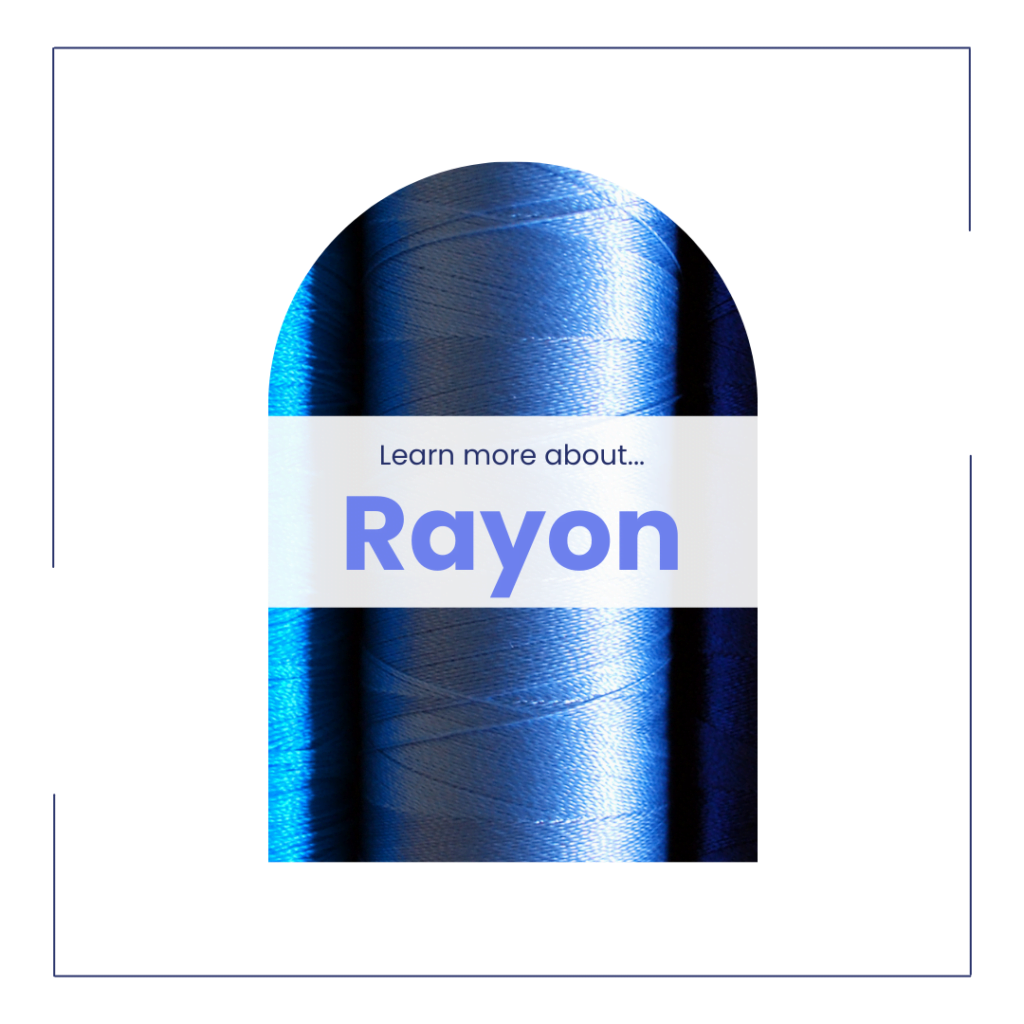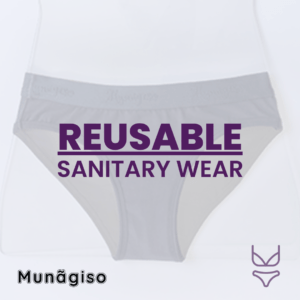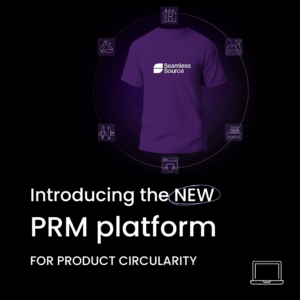Rayon is the common term for a group of semi-synthetic fabrics used widely within the fashion industry. Rayon can be produced using different processes, such as the viscose process or the modal process – however, these will simply be referred to as viscose and modal within this article.
We will explore the different types of rayon and the production processes of these variants below. This article also forms part of our series containing information about a variety of synthetic and natural fibres, so read on to discover more.
Overview
Rayon is a manufactured fibre and a type of semi-synthetic material that is somewhere in between natural and man-made. Instead of being naturally occurring from plants or animal fibres like cotton or wool, or made from plastics such as polyester, rayon is produced using cellulose.
Cellulose means that the material contains cells (which are always natural materials). Cellulose derived materials are usually made of either plants or wood, and different types of rayon are individually derived from products such as wood pulp and beech trees.
To produce rayon, the cellulose materials are blended and then chemically treated to create fibres mimicking the quality of natural fabrics. These fibres can either be left as they are, or recombined to create uniquely textured rayon fabrics.
Types and production of rayon
There are 3 main types of rayon produced today – these are viscose, lyocell and modal. Viscose is the most widely used of the derivatives within the fashion industry today, however, lyocell and modal are still frequently incorporated into garments.
There are also speciality rayon blends that are designed for certain features and are commonly used as a replacement for decorative natural fabrics at a cheaper price point.
Viscose
Viscose is usually what people are talking about when they mention rayon. If a garment is marked as being made of rayon, it is likely that they are referring to viscose rayon as viscose can be used interchangeably as a synonym for rayon itself, not just the specific production method.
The term ‘viscose’ refers to the viscous organic liquid (sometimes described as honey-like) which is regenerated into fibres to create the fabric once in solid form. It was first manufactured in 1883 as an affordable alternative to natural silk.
Viscose is primarily made up of wood-pulp which can be derived from a range of trees such as:
- Beech
- Pine
- Spruce
- Hemlock
- Eucalyptus
- Bamboo
- Soy
- Sugarcane
The reason that viscose is the most popular rayon fabric is that it is produced purely from wood-pulp cellulose, and does not have to be made with lignin-free cellulose. This manufacturing method is much cheaper than alternatives, as well as being able to be made on a large scale, and therefore it is more popular.
The process for producing viscose is extensive – having to transform from an organic fibre into a chemically treated material. These are the steps for viscose the production process:
- Cellulose extraction: viscose production begins with the creation of wood pulp cellulose – this is done through dissolving wood chips in chemicals such as sodium hydroxide. To create quality fabric, the cellulose used should be at least 90% pure.
- Chemical breakdown: The wood pulp containing the cellulose is then dissolved in caustic soda, turning it into an alkali solution. The process removes all impurities from the solution, making it a clean raw material to start fabric production.
- Pressing: the alkali solution is pressed between rollers which remove unnecessary liquid and form-pressed sheets. These are shredded into crumbs and with carbon disulfide.
- Ageing: the crumbs are dissolved in chemicals such as sulfuric acid, creating the viscous solution.
- Filtering: the product is filtered to remove any undissolved elements within the viscous liquid
- Degassing: this eliminates bubbles of air trapped in the solution that may cause weak spots in the fibre and therefore preventing tears in the final garments.
- Spinning: the solution is then forced through a spinneret, a machine making filaments of regenerated cellulose. The regenerated cellulose fibres are spun into yarns to be woven or knit into the viscose fabric.
Viscose is extremely versatile and can be utilised in a range of ways including blending with fibres such as cotton and polyester to create strong and cheap materials.
Modal
Unlike viscose, modal is not a silk substitute, and the fabric is made from a blend of materials. Beech-tree pulp is used for the cellulose part of the process, and then the material is blended together with other natural or synthetic fibres like cotton or spandex to create a strong yet synthetic material.
Modal is stronger than viscose for this reason, and therefore is more expensive than buying viscose, it is also more expensive than cotton. Modal was first developed in 1951 in Japan and is now widely used throughout the industry.
Modal is also known as HWM rayon (used within consumer textiles). Lower concentrations of NaOH are used to create modal which results in less toxic waste. the production process of modal includes:
- Harvesting: trees are split into small pieces and then transported onto the manufacturing floor. These chips are purified to extract their cellulose content.
- Steeping: the extracted cellulose is formed into sheets. These sheets are then dipped in sodium hydroxide.
- Breaking: once the sheets are soaked, they are divided into crumbs. The crumbs are submerged in carbon disulfide, which turns the white crumbs into an orange substance called sodium cellulose xanthate.
- Yarn: the cellulose xanthate is dipped in caustic soda again to create a syrup solution. The modal production process bypasses the aging process that usually occurs. This syrup is then put through a spinneret to form fibers.
- Finishing: the fibres are then dipped in sulfuric acid, stretched and formed into yarns. These strands are washed, bleached, rinsed, dried, and loaded onto reels.
Modal can have a variety of different treatments applied to it once production has occurred, such as pre-shrinking, fireproofing, wrinkle-proofing before it is woven into the fabric.
Lyocell
Lyocell is made from beech trees (and sometimes eucalyptus, oak and birch) blended together with other fibres such as cotton and spandex, similar to that of modal. However, the major difference between lyocell and modal is that lyocell is made with fewer harsher chemicals than that of modal fabric.
In the 1980s, lyocell rayon was developed in Courtaulds Research as a non-polluting alternative to modal and viscose because of its fewer chemicals. Less hard chemicals make the fabric softer and smoother and means the process and end product are more environmentally friendly than its viscose and modal rayon siblings.
The production process differs from viscose and modal, accounting for the changes to blend with the other synthetic or natural materials. The fibre is produced based on the N-methyl morpholine-N-oxide (NMMO) dissolution method:
- Dissolution: this step involves breaking down the pulp fibres and mixing them with solvent. Cellulose is dissolved in a system containing NMMO to form the viscous liquid. This dissolving is much simpler than the viscose process, as the dissolution of the dissolved pulp consists of the mercerization phase, ageing, and xanthation using carbon disulfide.
- Filtration: the liquid is filtered to remove coarse ingredients.
- Spinning Regeneration: the liquid is put through a spinneret nozzle into an air gap, and then regenerated.
- Washing: the resulting lyocell fibres are washed and the remaining NMMO is recovered and recycled.
- Finishing: this step includes bleaching, finishing, and drying.
Lyocell is the most absorbent of rayon materials, which means that it is great for wicking the moisture away from the body, meaning that the person wearing it will stay cool and dry for longer.
Lyocell has recently been referred to as a ‘miracle fabric’ due to its properties and sustainable nature. One type of lyocell that has emerged is known as Tencel, which is a brand of lyocell sold by Lenzing AG, and it is said to be on track to replace viscose within the industry within the next ten years.
Where are rayon fabrics made?
Rayon is produced in larger factories due to the complex process that it takes to make it. Multiple different chemicals and different machines are necessary to make the different types of rayon – so manufacturers usually have to have access to a lot of technical equipment which can cost a lot of money.
This means that larger countries with a high textile output are usually the top producers of the fabric. The largest producers of rayon worldwide are eastern countries such as India, China, Pakistan and Indonesia. China is the biggest producer of both viscose and modal rayon types.
The United States and the United Kingdom used to be some of the largest producers of rayon, however, due to the need for cheaper labour, overseas territories were favoured. This means that manufacturers have a larger profit margin whilst working, as rayon is a cheap fabric.
Manufacturers of rayon – specifically viscose (which is a cheaper variety) also usually want large-scale production, and therefore the laws in countries such as India and China make it easier to do this.
Rayon fabric properties
The different varieties of rayon are widely used throughout the fashion industry due to their properties. Some properties vary by the production method or finishes used on the fabrics. For example, viscose and lyocell are hypoallergenic because of their low permeability. The most common properties of rayon include:
Breathable
Viscose is highly breathable and is perfect for wear during the summer months. Viscose is very similar to cotton in this way, and this is why it is frequently used as a replacement for cotton – especially within basics such as t-shirts and vests.
Modal is very breathable and is often used in sports clothing due to the weave.
Absorbency
Viscose is super absorbent, with moisture-wicking properties. Viscose does not trap heat, which makes it the perfect fabric for activewear garments. Rayon is so absorbent because of the chemical processes that the fabric goes through in the production stages.
Modal and lyocell are estimated 50% more absorbent than cotton – which makes them the preferred choice on hot summer days.
Comfort
Rayon fabrics tend to be very comfortable to wear. Modal is incredibly soft to the touch and therefore is often used within garments worn close to the skin. Lyocell is also extremely soft and is said to be very friendly to the skin when worn – lyocell is a more premium rayon and has a more luxurious feeling.
Durable
Viscose tends to deteriorate with continued wear and exposure to bright sunlight, it also stains very easily. Modal is extremely strong because of the tight weave and long fibres used to create the fabric.
Draping
All rayon types are extremely good for draping. This is because rayon fabrics are often made as a synthetic silk alternative, and therefore the drape is essential in order to mirror the qualities of the natural fibre. This is especially present in viscose silk.
The fabric is very free-flowing and can be used within clothing and for decorative purposes because of its beautiful finish. Modal also does not crease easily, which makes it perfect for high-end looking garments.
Colour-fastness
Rayon has a tendency to differ with colour-fastness depending on the process, so it is important to read the care label properly before it is laundered.
Viscose has excellent colour retention and can hold dye for a long time despite numerous washings. On the other hand, modal has a tendency to absorb dye in warm water, however, it does not release dye during the laundering process.
Shrinkage
Viscose is very prone to shrinkage and may shrink with every wash. This is because of the fabrics delicate structure, which also makes viscose prone to breaking apart in the washing machine. Washing viscose should be done with care – and it should not be tumble dried as it needs to lay flat in order to retain its original shape.
Modal does not shrink as easily as viscose does – modal is much less likely to shrink than any other type of rayon because of its manufacturing process. This makes the slightly more expensive option better when it comes to the longevity of the garment it is used within.
Pilling
Modal rayon resists pilling and instead has a smooth finish which is perfect for everyday wear. This is possible due to it being blended with an array of different fabrics. Lyocell is prone to pilling due to its low surface energy.
Biodegradable
Modal and lyocell are 100% biodegradable, this is because, despite the chemicals, modal and lyocell are naturally formed substances from wood-pulp and are able to be broken down over time.
Rayon fabric products
There are a multitude of uses for rayon fabrics within the fashion and textiles industry. Rayon has many beneficial properties which make it the perfect choice for many different types of products on the market.
Viscose
Viscose can be used to make artificial silk, and can also be used to make synthetic velvet depending on the final production stages.
Viscose is the perfect fabric for items such as dresses as the drape of the fabric makes the garment look classy and expensive without it costing a lot to produce. Viscose is often used by high-street – mid-market brands for this reason.
Viscose is great for both casualwear and formalwear – as it is a very versatile fibre. As well as being great for dresses, it can also be used for casual t-shirts and blouses due to its light and airy nature.
Viscose is also great for activewear – because of its ability to be moisture-wicking and breathable, it is a common choice for more price-friendly activewear garments.
Viscose can also be used widely outside of the fashion industry as well, and is frequently used for things such as curtains due to its luxurious appearance and mattress protectors as it can absorb water easily.
Modal
Modal is a soft and durable fabric and is therefore usually referred to as the ‘underwear fabric’. It has been used widely in products from undergarments and pyjamas to bedsheets, pillowcases, towels.
Modal is primarily used in clothing and for the home as it tends to be more expensive to produce than viscose. Modal is good for holding its shape and is a lot stronger when wet than viscose, so can be used in more extreme environments than its rayon sibling.
Lyocell
Lyocell is a premium alternative and is mostly produced by the brand Tencel, whom use the fabric in a range of different garments as a more eco-friendly version of viscose.
It is used frequently for denim, activewear, homeware, footwear such as sandals and shoes and in luxury products such as premium dresses for its drape and smooth nature.
Lyocell can also be blended with luxury natural fibres such as silk, cashmere and wool to produce extremely high-quality and versatile fabrics for luxury consumption.
Sustainable impact of rayon
The environmental impacts of rayon can be evaluated from multiple stages in the production process. With various different rayon varieties all being cellulose-based – a natural product, the base might not be considered as harmful to the environment as synthetic fabrics such as polyester and nylon.
However, the sustainability and ethicality of rayon depends on the origin of the materials used – for example, even though the materials are mostly naturally derived from wool-pulp, this could be impacting concerns such as deforestation etc. In order to combat this, plants such as eucalyptus and bamboo can be used instead of more widely forested trees – as they grow much more rapidly than other varieties and this avoids old forests being cut down from rayon production.
In the manufacturing process of rayon – several different materials can also be used to make varieties such as modal specifically, and these can be both natural or synthetic. This can be an issue as the base for the fibre is then not naturally derived and this will go on to have an even higher impact on the environment.
The chemicals used within the manufacturing process are extremely hazardous, and one of the reasons that production moved away from the US and the UK. Rayon production is often too toxic for these countries’ laws, and therefore production moved to asian countries with more relaxed laws in place.
Whilst rayon is considered safe to sell, the factory workers making it can be at risk from neurophysiological effects, nerve damage, heart disease and stroke. Factories also dump the chemicals doing this (such as formaldehyde) into waterways, poisoning whole communities.
According to a report that came out in 2017 by the Changing Markets Foundation – in Indonesia, rayon factory workers have been found washing the chemicals off of rayon textiles right in the river. In China, there’s abundant evidence of rayon production poisoning workers and the local bodies of water, even turning a lake black. In India, a plant is dumping into a tributary to the Ganges, poisoning local families, causing the mental faculties of children to degenerate before they reach their teens.
Modal rayon is said to be more environmentally friendly than viscose because lower concentrations of sodium hydroxide are used to make it, and a closed-loop processing system is used within production. However, viscose, modal and lyocell are still environmentally harmful because of their impact in the palm oil industry.
Palm oil is responsible for mass deforestation, and all types of rayon allow this to happen as they use the trees already there for the production of the fabric, despite claims otherwise.
The only type of rayon that may be a sustainable option is lyocell – similarly to modal, it does not use as many chemicals, and lyocell produced by Tencel (a trademarked fabric by Lenzing) is made of 100% sustainable sourced eucalyptus, meaning that it doesn’t contribute to deforestation. However, the best option would be to choose silk instead of its rayon lookalike.




